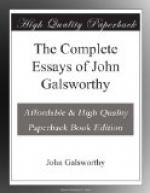Yes—I thought—and this Art is the one form of human energy in the whole world, which really works for union, and destroys the barriers between man and man. It is the continual, unconscious replacement, however fleeting, of oneself by another; the real cement of human life; the everlasting refreshment and renewal. For, what is grievous, dompting, grim, about our lives is that we are shut up within ourselves, with an itch to get outside ourselves. And to be stolen away from ourselves by Art is a momentary relaxation from that itching, a minute’s profound, and as it were secret, enfranchisement. The active amusements and relaxations of life can only rest certain of our faculties, by indulging others; the whole self is never rested save through that unconsciousness of self, which comes through rapt contemplation of Nature or of Art.
And suddenly I remembered that some believe that Art does not produce unconsciousness of self, but rather very vivid self-realisation.
Ah! but—I though—that is not the first and instant effect of Art; the new impetus is the after effect of that momentary replacement of oneself by the self of the work before us; it is surely the result of that brief span of enlargement, enfranchisement, and rest.
Yes, Art is the great and universal refreshment. For Art is never dogmatic; holds no brief for itself you may take it or you may leave it. It does not force itself rudely where it is not wanted. It is reverent to all tempers, to all points of view. But it is wilful—the very wind in the comings and goings of its influence, an uncapturable fugitive, visiting our hearts at vagrant, sweet moments; since we often stand even before the greatest works of Art without being able quite to lose ourselves! That restful oblivion comes, we never quite know when—and it is gone! But when it comes, it is a spirit hovering with cool wings, blessing us from least to greatest, according to our powers; a spirit deathless and varied as human life itself.
And in what sort of age—I thought—are artists living now? Are conditions favourable? Life is very multiple; full of “movements,” “facts,” and “news”; with the limelight terribly turned on—and all this is adverse to the artist. Yet, leisure is abundant; the facilities for study great; Liberty is respected—more or less. But, there is one great reason why, in this age of ours, Art, it seems, must flourish. For, just as cross-breeding in Nature—if it be not too violent—often gives an extra vitality to the offspring, so does cross-breeding of philosophies make for vitality in Art. I cannot help thinking that historians, looking back from the far future, will record this age as the Third Renaissance. We who are lost in it, working or looking on, can neither tell what we are doing, nor where standing; but we cannot help observing, that, just as in the Greek Renaissance, worn-out Pagan orthodoxy was penetrated by new philosophy; just as in the Italian Renaissance,




